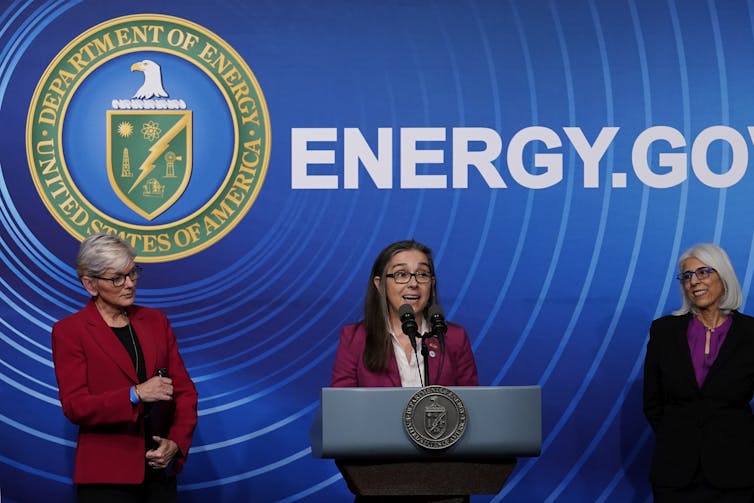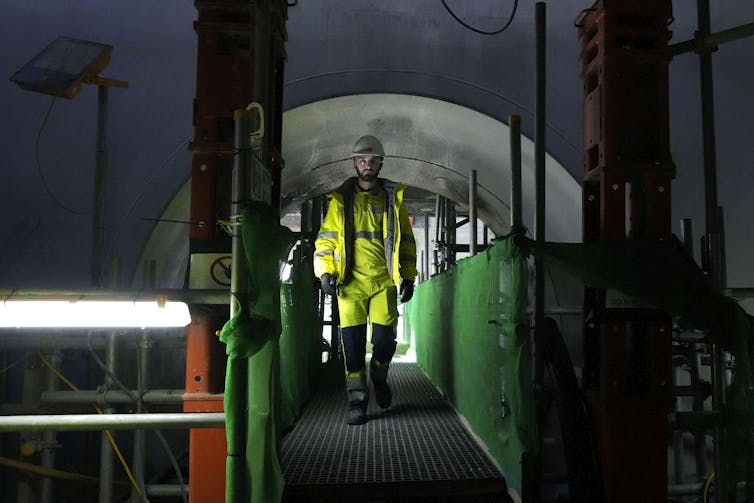
The U.S. Department of Energy reported a major scientific breakthrough in nuclear fusion science in December 2022. For the first time, more energy was released from a fusion reaction than was used to ignite it.
While this achievement is indeed historic, it’s important to pause and reflect on the way ahead for fusion energy.
We are professors of sustainable and renewable energy engineering at Carleton University, where we research alternative energy technologies and systems that can move us to a low-carbon future.
We also teach our students how to navigate the treacherous terrain from lab-based findings to real-world applications.
Defining system boundaries
The efficiency of a potential fusion energy power plant remains to be seen. The reported fusion net gain actually required about 300 megajoules of energy input, which was not included in the energy gain calculation. This energy input, needed to power 192 lasers, came from the electric power grid.
In other words, the experiment used as much energy as the typical Canadian household does in two days. In doing so, the fusion reaction output enough energy to light just 14 incandescent bulbs for an hour.
The same is true of nuclear fission, which is the reaction inside current nuclear power plants. The complete fission of one kilogram of Uranium-235 — the fissile component of nuclear fuel — can generate about 77 terajoules. But we cannot convert all of that energy into useful forms like heat and electric power.
Instead, we have to engineer a complex system that can control the nuclear fission chain reaction and convert the generated energy into more useful forms.

This is what nuclear power plants do — they harness the heat generated during nuclear fission reactions to make steam. This steam drives a turbine connected to an electric power generator, which produces electricity. The overall efficiency of the cycle is less than 40 per cent.
In addition, not all of the uranium in the fuel is burned. Used fuel still contains about 96 per cent of its total uranium, and about a fifth of its fissile Uranium-235 content.
Increasing the amount of uranium spent in our current fleet is possible — it’s an ongoing sphere of work — but it poses enormous engineering challenges. The huge energy potential of nuclear fuel is currently mitigated by the engineering challenges of converting that energy into a useful form.
From science to engineering
Until recently, fusion has been seen primarily as a scientific experiment, not as an engineering challenge. This is rapidly changing and regulators are now investigating how deployment might unfold in the real world.
Regardless of the efficiency of a future fusion power plant, taking energy conversions from basic science to the real world will require overcoming a multitude of challenges.
Because fission faced many of the same challenges as fusion now does, we can learn a lot from its history. Fission also had to move from science to engineering before the commercial industry could take off.
The science of fusion energy, as with nuclear fission, is rooted in efforts to develop nuclear weapons. Notably, several nuclear physicists who helped develop the nuclear bomb wanted to “prove that this discovery was not just a weapon.”
The early history of nuclear power was one of optimism — of declarations the technology would advance and be able to meet our need for ever-increasing amounts of energy. Eventually, fusion power would come along and electricity would become “too cheap to meter.”
Lessons learned
What have we learned over the past 70 years since the onset of nuclear power? First, we’ve learned about the potentially devastating risk of technology lock-in, which occurs when an industry becomes dependent on a specific product or system.
Today’s light-water fission reactors — reactors that use normal water as opposed to water enriched with a hydrogen isotope — are an example of this. They were not chosen because they were the most desirable, but for other reasons.
These factors include government subsidies that favoured these designs; the U.S. Navy’s interest in developing smaller-scale pressurized water reactors for submarines and surface warships; advances in uranium enrichment technology as a result of the U.S. nuclear weapons program; uncertainties regarding nuclear costs that led to the assumption that large light-water reactors are simply scaled-up versions of smaller ones; and conservatism regarding design choices given the high costs and risks associated with nuclear power development.
We have been struggling to move to other technologies ever since.
Second, we’ve learned that size matters. Large reactors cost more to build per unit of capacity than smaller units. In other words, engineers misunderstood the concept of economies of scale and doomed their industry in the process.
Large infrastructure projects are extremely complex systems that rely on enormous work forces and co-ordination. They can be managed, but they usually go over-budget and fall behind schedule. Modular technologies exhibit better affordability, cost control and economies, but micro and small nuclear reactors will also be economically challenged.

Third, regulatory regimes must be developed for fusion. If the industry coalesces too quickly around a first-generation design, the consequences for the regulation of future reactors could be severe.
Fourth, choosing locations for new power plants and societal acceptance are key. Fusion has an advantage because its technology is more of a blank slate than fission when it comes to public opinion. The positive associations the public has with fusion must be maintained by prudent design decisions and adopting best practices for community engagement.
The same is true of how the industry will choose to handle the waste challenge. Fusion reactors generate large amounts of waste, though not the same kind fission does.
A call to action
Our research on nuclear energy innovation reveals that challenges facing nuclear fusion can be overcome, but they require prudent leadership, decades of research, significant amounts of funding and focus on technology development.
Billions of dollars are needed to advance nuclear fission technology, and we have far more experience with fission than with fusion. An appetite for funding must be demonstrated by governments, electric utility companies and entrepreneurs.
Fusion’s promise is vast and there is exciting work being done to advance it outside of this recent breakthrough, including by private companies. Decades of research and development are needed before fusion can meaningfully contribute to our energy system.
Our central message is a call to action: fusion engineers, researchers, industry and government must organize to investigate and mitigate the challenges that face fusion, including in the design of the first generation of power plants.
There is no substitute to deep and rapid decarbonization of the energy system if we want to save our planet from climate catastrophe. We are proud to be training the next generation of energy engineers to design new and better energy solutions.
Kristen Schell, Assistant Professor, Mechanical and Aerospace Engineering, Carleton University and Ahmed Abdulla, Assistant Professor, Mechanical and Aerospace Engineering, Carleton University
This article is republished from The Conversation under a Creative Commons license. Read the original article.











